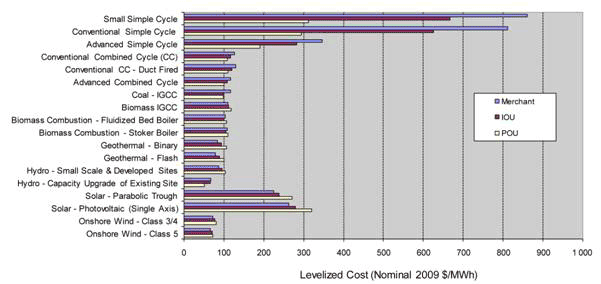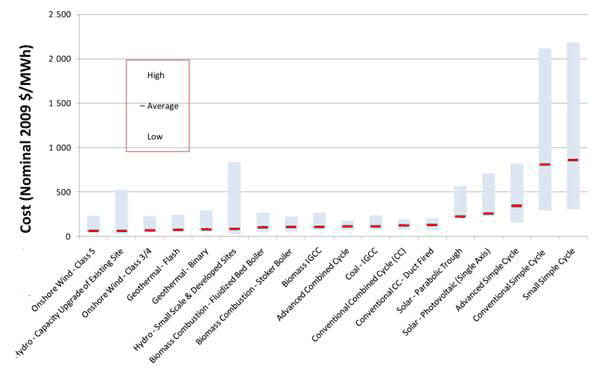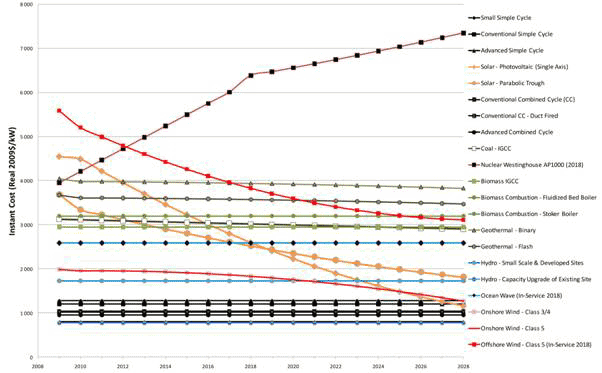Renewable energies not only cleaner, but also cheaper, especially in the long run Dr. Mae-Wan Ho
California new governor Jerry Brown has called for building 12 000 MW of distributed electricity generation out of 20 000 MW total renewable energy capacity by 2020. The total new renewables capacity of 20 000 MW could generate 30-40 TWh per year for about 10-13 percent of consumption, and over half of that would come from distributed small scale facilities.
Brown said on his weblog [1]: “My goal is that by 2020, California should produce 20,000 new megawatts (MW) of renewable electricity, and also accelerate the development of energy storage capacity. California can do this by aggressively developing renewables at all levels: small, onsite residential and business systems; intermediate-sized energy systems close to existing consumer loads and transmission lines; and large scale wind, solar and geothermal energy systems. At the same time, California should take bold steps to increase energy efficiency.”
Significantly, the plan includes 12 000 MW, or 60 percent “Localized Electricity Generation”. These are “onsite or small energy systems located close to where energy is consumed that can be constructed quickly (without new transmission lines) and typically without any environmental impact.”
Brown envisages solar systems of up to 2 MW installed on roofs of warehouses, parking lots, schools, and other commercial buildings throughout the state; solar energy projects up to 20 MW to be built on public and private property, such as for example, creating the California Solar Highway with solar panels placed all along California’s state highways.
He said the California Public Utilities Commission (CPUC) or Legislature should implement “a system of carefully calibrated renewable power payments (commonly called feed in tariffs)” for distributed generation projects up to 20 MW. “Holding down overall rates must be part of the design.”
This ambitious scheme would create half a million new jobs in research, development, manufacturing, construction installation, and maintenance over the next decade.
Brown is forging ahead with a comprehensive renewable energy programme; but not quite on the scale that his predecessor Arnold Schwarzeneger has intended. It is instructive to look at the detailed costing of renewable energies that has been carried out under the previous governor.
Within the past several years, California has been buzzing in the renewable energy market, largely driven by key legislations that have the “ambitious but achievable” [2] goals of 20 percent renewables by 2010 and 33 percent by 2020, 30 000 capacity of solar photovoltaic installed within a decade, and an 11 percent reduction in greenhouse gas emissions by 2010.
The California Energy Commission prepared an Integrated Energy Policy Report in 2007. The private firm KEMA Inc., was commissioned in 2009 to carry out a detailed analysis of costs including installation, operation, transmission, maintenance, lifetime, capacity factor (ratio of actual power delivered over nominal capacity), waste disposal, and decommissioning (nuclear), as an update to the 2007 Report. The instant costs were calculated based on 2009 dollars, and also projected to the next 20 year period. The costs per energy or power unit were worked out for 15 renewables, together with utility scale coal-integrated gasification and combined-cycle (IGCC) and nuclear power.
Most of the energy options have little or no expected improvement over the next 20-year period, except for two renewable technologies that are important for California – wind and solar – which show a significant cost decline. Solar photovoltaic, which has seen substantial cost reduction since 2007, is projected to show the greatest improvement of all, bringing its capital cost within the range of the gas-fired combined cycle units near the end of the study period [3].
The unit cost of each option depends on complicated and unpredictable assumptions of financing, operational costs, and most importantly, tax credits. The utilities can be financed by private investors or merchants, investor-owned (IOUs), or publicly owned (POUs).
IOU plants are typically less expensive than merchant facilities due to lower financing costs. However, some merchant renewable technology plants, such as solar units, can be less expensive due to the effect of cash-flow financing with tax benefits. The POU plants generally the least expensive because of lower financing costs and tax exemptions. However, where tax benefits are large, a merchant facility or IOU can cost less.
The instant cost of different options per MWh of energy is given in Figure 1.

Figure 1 Cost of different energy options per unit of energy delivered
Figure 2 gives the high average and low values of the unit energy costs. The range of values are perhaps more important than the average, as it shows how volatile the costs are.

Figure 2 Range of unit energy costs of different options
Figure 3 gives the projected cost of unit power (in 2009$/W) over twenty years from 2009 to 2018.

Figure 3 Projection of unit power cost of different options over 20 years
The graphs in Figures 1-3 omitted the nuclear option, estimated at $4 000/kW in 2009 [2]. That estimate falls on the low side of a range of other estimates reaching as high as $10 553/kW (see [4] The Real Cost of Nuclear Power, SiS 47).
A 1976 legislation prohibits the construction of new nuclear power plants in California until the federal government approves a technology for high-level waste disposal and/or spent fuel reprocessing [5]. Until then, the nuclear ban remains in place. California is wise to exclude the nuclear option.
Another option missing from the portfolio is biofuels. The US Department of Agriculture Agencies in California has held twelve public meetings on biofuels in October 2010 to seek public comments on how USDA agencies can assist California’s biofuel’s industry [6].
A draft 2011 Bioenergy Action Plan has been drawn up [7] by the California Energy Commission in December 2010, an update of the 2006 Bioenergy Action Plan. It identifies actions that the state agencies will be taking to implement Executive Order S-06-06, which commits California to generate 20 percent of the state’s renewable energy from biopower (biomass to electricity) by 2010 and 2020, and producing 20 percent of its biofuels (biomass-based transportation fuels) within the state by 2010, 40 percent by 2-2-, and 75 percent by 2050.
I have written on the unsustainability of biofuels from ‘energy’ crops time and again (see latest report [8, 9] Biofuels Waste Energy to Produce, Scientists Expose Devastating False Carbon Accounting for Biofuels, SiS 49) and their indisputable role in precipitating the food crisis by taking away land from food production and increasing landlessness [10] Biofuels and World Hunger, SiS 49). Here, to complete the picture, we want to know at a minimum, what it costs to produce corn ethanol, the most common biofuel in the US.
The cost of corn ethanol is obviously tied to the cost of corn, which is highly volatile, as speculators and major hedge funds and investment banks have entered the agricultural market (see [11] Financing World Hunger, SiS 46). A realistic life-cycle accounting published in 2009 put the cost of producing 1 litre of corn ethanol at US$1.05 [12], which is equivalent to $176 per MWh, making it much more uneconomic than biomass (see Fig. 1). Furthermore, it uses 46 percent more fossil fuel energy to produce. Yet, subsidies for corn ethanol total more than $6 billion per year, which means that it is subsidized at 60 times per litre of gasoline. Biofuels may be renewable, but not at all sustainable, and definitely not green (see [13] Green Energies - 100% Renewable by 2050, ISIS publication).
California should take the lead in making the right choices.
Article first published 19/01/11
Comments are now closed for this article
There are 1 comments on this article.
Todd Millions Comment left 21st January 2011 22:10:39
Hopefully this time,Goc Brown isn't as beholden too the areonatical/armerments mafia as he was last time.Using this effort too improve the state finances-At the same time will also prove fraught,but not I think hopeless-unless anouther enron is allowed too gut them out(again).The previous governators policies were rather o'shadowed by him allowing his patron Ken Lay too get away with all the powerscam loot("don't be economic girlie men"-was rather droll,when if knew the crocked E that had just being tatooed across his butt,was still bleeding.)Today the politicians and pundits of the nuc armed bananna republic too the south of me are howling and foaming over Evergreen solar moving to China-due to goverment support.This is indeed a magor loss,but one of my favorite panel companies have played it poorly-They should have stressed that the massive multilevel goverment subsidies too the nuc,oil,coal and gas mass posioning mafias in the USA,that are continuing, despite sure to be fatal bledout by crimminal subsidy,makes moving too a market where the goverment isn't as willfully stupid- imperitive.They certianly wouldn't look north for this.